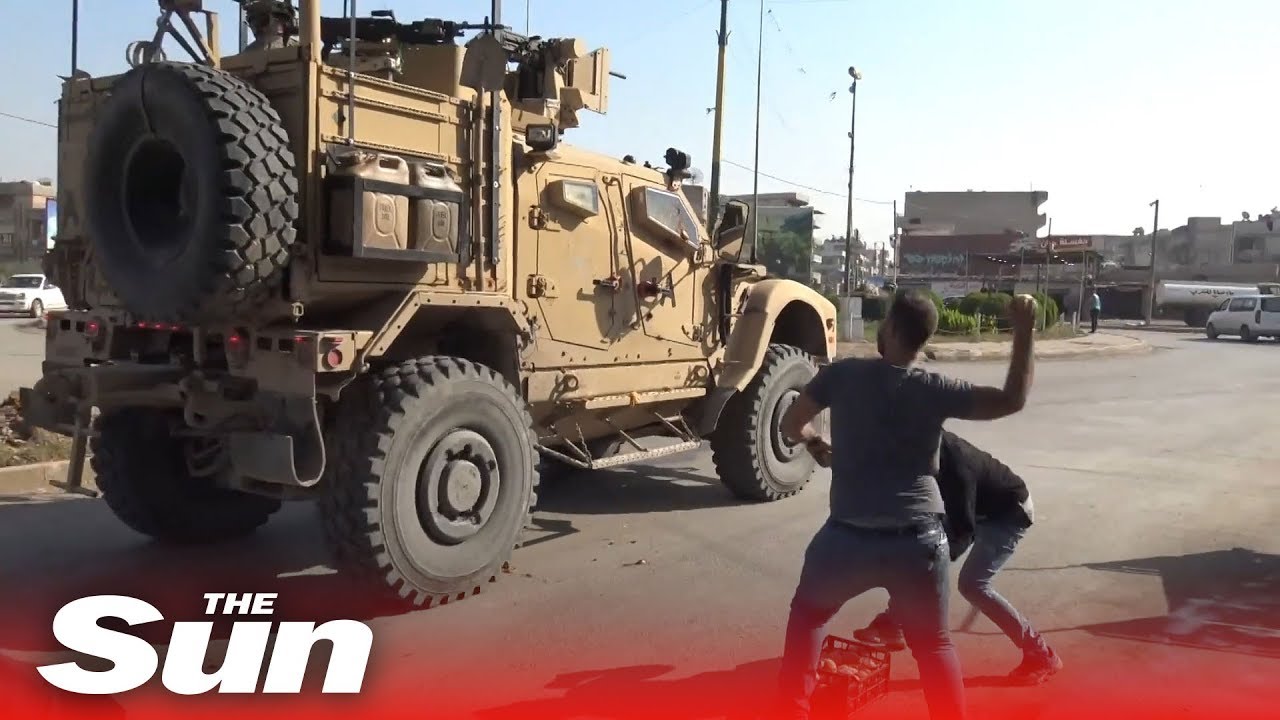

U.S. troops pelted with rocks, rotten fruit near Syria-Turkey border.
The U.S. Department of “Defense” plans to keep its troops in Syria. This may come as a surprise to those who assumed that dumping support for the Kurdish militias meant the Pentagon finally intended to withdraw.
The sudden convenient execution of Abu Bakr al-Baghdadi by U.S. forces on Oct. 27 rips apart the justification that U.S. troops are needed to combat reactionary Islamic State group (IS) forces. Despite years of bombing Syria, the U.S. never attacked the thousands of tankers stealing Syria’s oil while its northern oil fields were under IS control.
The Pentagon is “considering how we might reposition forces in the area in order to make sure that we secure the oil fields,” U.S. Secretary of Defense Mark Esper told a meeting of NATO defense ministers on Oct. 25. (defenseone.com, Oct. 25) This serious escalation involves “half of an Army armored brigade combat team battalion that includes as many as 30 Abrams tanks,” along with roughly 500 U.S. troops, and “would include some mechanized units.”
Mechanized forces, including tanks that are not presently in Syria, will require hundreds of U.S. troops to deploy, supply and protect the projected tanks and armored units.
While cynically claiming to withdraw from endless U.S. wars, President Trump tweeted: “We’ve secured the oil and, therefore, a small number of U.S. troops will remain in the area. Where they have the oil. And we’re going to be protecting it, and we’ll be deciding what we’re going to do with it in the future.” (time.com, Oct. 26)
That arrogant statement shows that the flagrant piracy of Syria’s resources is more open than ever before.
So what is actually on the drawing boards of military strategists is how and where to reposition troops and prepare for another escalation.
All U.S. efforts failed
However, U.S. efforts to dismember Syria are increasingly in disarray. Attempts to overturn the elected Assad government have failed. The brutal tactics included 16 years of sanctions, eight years of financing hundreds of thousands of mercenary forces, and finally five years of bombing and direct military intervention.
Every tactic was used to inflame national, ethnic and religious division. U.S. bombers targeted schools, hospitals, bridges and industrial centers.
But Syria was able to maintain military resistance and national unity while gaining international assistance. U.S. forces are no longer able to hold the one-third of Syria in the oil-rich north, nor the corridor that included a substantial U.S. military presence in Iraqi Kurdistan, allied with Kurdish militia units.
The former head of the U.S. Central Command, retired Gen. Joseph Votel, admitted that framing the issue as defending the oil fields from IS is “largely unfounded.”
“We looked at the oil fields in the context of their strategic value,” he said, adding they would be “a good negotiating leverage point” for eventual discussions between the government in Damascus and the Kurdish militia. (New York Times, Oct. 25)
Iraq refuses more U.S. troops
The Iraqi military publicly contradicted Defense Secretary Esper, who had said all U.S. troops leaving Syria would go to western Iraq and would continue to conduct operations from there.
The Iraqis issued a statement that U.S. troops did not have permission to stay in Iraq. Withdrawing U.S. troops were publicly pelted with rocks and potatoes in both Qamishli, Syria, and Irbil, Iraq. (CBS News, Oct. 22)
The Pentagon had been forced to pull out of Iraq in 2011 after overwhelming popular resistance to the more than 150,000 U.S. occupation forces. Even the Iraqi Parliament, whose members had been vetted and approved by U.S. occupation forces, refused to grant a Status of Forces agreement to the U.S. military.
In 2014, supposedly to protect Iraq from the sudden emergence of IS, U.S. troops had gone back into the Kurdish region of Northern Iraq. Now calls are increasing for their withdrawal.
Trump’s tweets back in February, when he said that U.S. troops would stay in Iraq as a base for operating in Syria and for monitoring Iran, created a furor among all Iraqi political currents.
U.S. imperialism has been involved in efforts to destroy both Iraq and Iran for almost 4 decades, since the 1980 Iran/Iraq War. It has tried in every way to envenom antagonisms between Arab and Kurdish national groups and Sunni and Shia religious groups.
The Pentagon presently has more than 5,000 military personnel and thousands of contractors in Iraq. In addition, there are hundreds of projects run by nongovernmental and civil society organizations funded by the U.S. Agency for International Development programs, the National Endowment for Democracy and other U.S. government and corporate entities, along with U.N. agencies. All these programs supposedly provide humanitarian relief from years of U.S. occupation. But they really keep Iraq divided and dependent.
In past years U.S. officials declared they were involved in Syria and Iraq to defend democracy, or to defend one national grouping against another, or to combat the threat of IS terror.
U.S. strategists pulled into their imperialist coalitions members of the European Union, Britain, the Gulf monarchies, Saudi Arabia, Israel, Jordan and Turkey. All that has collapsed.
Whether this latest scheme will succeed any more than the past 16 years of destructive wars remains to be seen. But it will be challenged on every front by forces that are politically sophisticated and wise to U.S. imperialist plans. It is essential to stay focused on the demand “U.S. out of Syria and Iraq!”
The following is Part 2 of a talk given by the author to a meeting…
Boston Students, professors and workers are confronting the Trump administration’s fascist crackdown at universities across…
Philadelphia Within days of Swarthmore students reviving a pro-Palestinian encampment on April 30, police arrested…
The No More 24 Campaign held a rally in front of City Hall on May…
Thessaloniki, Greece Two years ago there was a catastrophic accident on the railroad line that…
Download the PDF Black and white version In over 1,000 U.S. cities Workers mobilized for…